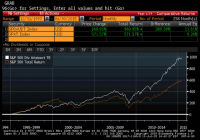Will China Pull Back Up SLV?
China’s possible economic slowdown may have contributed to the recent fall in the price of SLV. China’s demand for silver is expected to grow this year in part due to an increase in installation of solar panels. The physical demand for silver is less likely to impact the price of SLV. While all eyes are set towards the Greek debt crisis, the price of the iShares Silver Trust ETF (NYSEARCA: SLV ) has come down in the past few weeks. Some attributed the fall in prices , in part, to fears of an economic slowdown in China. Nonetheless, China’s demand for silver is still expected to rise this year. But will China pull up the price of SLV? As I have pointed out in the past, the physical demand for silver, while plays an important role in moving the price of silver, is still only secondary to the changes in the demand for silver for investment purposes. The same goes for China’s growing demand for silver. One of the main growing industries in China where the demand for silver has increased is in the photovoltaic business, i.e. the installation of solar panels. So far this year, China was able to ramp up its installation capacity – it reached 5.04 GW in the first quarter. This year, China set a high target of installing a total of 17.8 GW of solar PV. If so, this will account for nearly a third of the global solar PV installations for 2015. How much silver is needed to reach this 17.8 GW goal? According to PV-Tech , it takes nearly 80 tons of silver, or 2.8 million ounces of silver, to generate one gigawatt of electricity from solar. Considering China aims to install 17.8 GW, this means it will need around 50 million ounces of silver. On a global scale, with an estimate of 55 GW, the world’s demand for silver in the PV solar industry will be around 154 million ounces – nearly two and a half times the amount of silver consumed in this industry back in 2014; it’s also 14% of total physical demand of silver. Last year , however, this industry accounted for only 5.6% of the physical demand of silver. Moreover, the demand for silver in this industry has gone down since its peak year – 2011. Color me dubious, but I’m a bit skeptic that China will be able to reach such a high target, let alone need to ramp up its solar industry capacity so rapidly especially now that oil prices have gone down. Keep in mind, in previous years, the role of PV solar was small from the total global demand for silver. And China’s demand for silver, while important, hasn’t driven up the price of SLV in the past few years. But even if you do believe China’s demand for silver will rise and its economy isn’t slowing down, it’s still a stretch to consider this turn of events will increase the price of SLV. Thus, it’s less likely that China, even if it does increase its demand for silver, will drive up SLV. I think the drama in Greece, which has raised the uncertainty in the financial markets mainly in forex, and the potential change in the Federal Reverse’s policy in the coming months are likely to lead the way in moving the price of SLV. When it comes to the Fed, even though Yellen keeps promising it will raise rates this year, the market isn’t convinced: According to the bond market, the implied probabilities of a rate hike in September have fallen to only 14% and 50% in December. The minutes of the FOMC meeting revealed that some members still think it could be too soon to raise rates: “Most participants judged that the conditions for policy firming had not yet been achieved; a number of them cautioned against a premature decision.” Other members thought the conditions for a rate hike is plausible in the very near term: “Some participants viewed the economic conditions for increasing the target range for the federal funds rate as having been met or were confident that they would be met shortly. They identified several possible risks associated with delaying the start of policy firming. One such risk was the possibility that the Committee might need to tighten more rapidly than financial markets currently anticipate – an outcome that could be associated with a significant rise in longer-term interest rates or heightened financial market volatility.” The Greek saga could also push the rate hike to 2016 if Greece were to exit the EU; a Grexit could further raise the uncertainty in the financial markets and provide an excuse for the doves in the Federal Reserve to err on the side of caution by keeping rates low until the beginning of 2016 and see how the Greek exit plays out. China is expected to increase its demand for silver and the solar industry will likely to take a bigger role in the physical demand for silver. It’s still possible that China’s demand will grow slower mainly if its economy slows down. But as for the price of SLV, it seems less likely that even a higher growth path for China’s silver consumption will drive up, for extended periods, the price of this precious metal. (For more please see: ” Is SLV about to change course? “). Disclosure: I/we have no positions in any stocks mentioned, and no plans to initiate any positions within the next 72 hours. (More…) I wrote this article myself, and it expresses my own opinions. I am not receiving compensation for it (other than from Seeking Alpha). I have no business relationship with any company whose stock is mentioned in this article.
